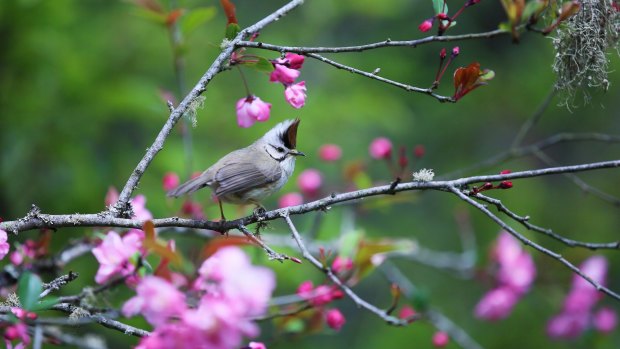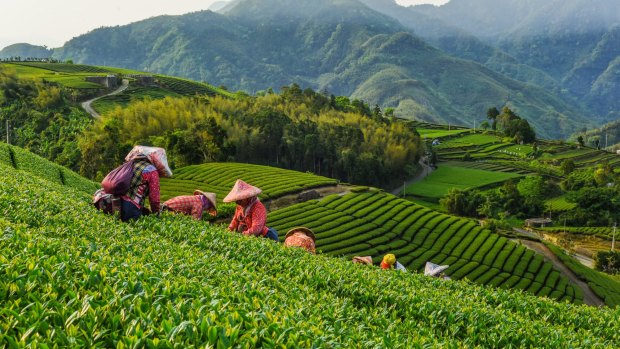By Mark Daffey

A yuhina among the blossoms at Alishan National Park.Credit: Shutterstock
Alishan's five "wonders" are well known among the Taiwanese. For many, they are the reason for coming here – to witness the sunrise, gaze over the "sea of clouds" blanketing the valley floors, ride on its narrow gauge railway, hike its forest trails and watch the sunset's lingering afterglow. But they could easily add a sixth wonder, possibly even two or three more.
Unlike the humid, industrialised coastal plains to the west, the air is blissfully fresh in these mountains, just 100 kilometres inland. And on an island that's roughly the size of Switzerland but with a population matching Australia's, the tourist crowds can disperse evenly throughout the 1400-hectare alpine reserve.
Alishan's original inhabitants were the Tsou, who still cultivate oolong tea and wasabi on its mountainous slopes, 2000 metres above sea level. Han immigrants from mainland China followed, then Alishan's timber reserves enticed Taiwan's Japanese overlords to the mountains during their 50-year occupation from 1895.

An oolong tea garden in Alishan.Credit: Shutterstock
The Japanese built a railway line from the lowland settlement of Chiayi to Alishan specifically for carting logs down the mountain. Then, when logging reserves declined in the 1970s, the area was declared a National Forest Recreation Reserve, with Alishan's tourist riches becoming its focal point.
Central to that push was my hotel, the 4.5-star Alishan House. One of just two located inside the Zhushan Forest, it is one of the oldest hotels in Taiwan, dating back to the 1930s. A rudimentary courtyard separates the hotel's old wing – referred to as the Historical House, where world leaders such as Singapore's Lee Kuan Yew have stayed – from the newer Modern Building where I bed down.
With 209 rainy days and 244 misty ones recorded on average here each year, the day of my arrival is like most others – rainy and misty. My chances of catching a lingering sunset appear slim. In the meantime I stroll around the hotel grounds, marvelling at the blossoming king cherry trees grown from cuttings said to have come from Japan's imperial gardens. Many consider them wonders in their own right.
Miraculously, by day's end the rains have ceased and the mist has cleared, enabling me to step onto the hotel's Star Terrace to witness a sunset that stains the skies in swirls of colour above a sea of clouds. That's two of the area's wonders ticked off right there.
The chance to cross out two more comes early next morning, when I board the train to Mt Ogasawara's Zhushan station in the pre-dawn darkness. Even considering the ungodly hour, every seat on the train's five carriages is occupied and the aisles are crammed to capacity. All have risen early to watch the sunrise over the adjacent peak, Jade Mountain – Taiwan's highest.
Frost coats the ground and patches of snow remain on Mount Ogasawara's uppermost flanks, where the itinerant hordes muster on a viewing platform purpose-built to witness the dawn spectacle. Again, clouds blanket the valleys beneath silhouetted ridge lines. It's the perfect sunrise – truly a wonder.
Only one wonders remains, the most accessible: hiking Alishan's forest trails.
As fortune has it, the morning is crisp and clear when I stroll around the looping, kilometre-long Giant Trees Plank Trail, stopping to enter decorative Buddhist and Taoist temples and to gaze up at towering cypress pines and cedar trees. The oldest, and biggest, now rests on its side near a railway station bearing its name. Believed to be more than 3000 years old, and with a height of 53 metres, the Alishan Sacred Tree was cut down in 1998 after being weakened by lightning strikes decades earlier. Considering the region's chequered history before then, it's a wonder it managed to survive that long.
TRIP NOTES
MORE
FLY
Taiwan's national carrier, China Airlines, flies direct to the Taiwanese capital, Taipei, from Sydney and Brisbane on a daily basis and three-times weekly from Melbourne. See china-airlines.com
STAY
Standard double rooms at Alishan House cost about $200 a night. See alishanhouse.hotel.com.tw
Mark Daffey visited Taipei as a guest of the Taiwan Tourism Bureau.
Sign up for the Traveller Deals newsletter
Get exclusive travel deals delivered straight to your inbox. Sign up now.